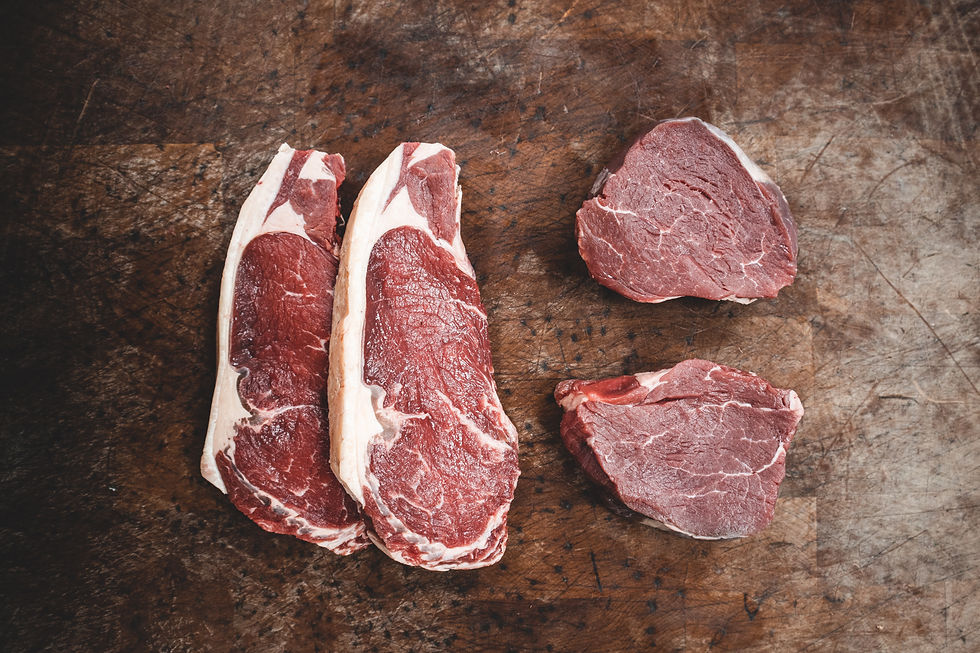Ever since Brexit dominated the news and international trade, particularly on food, was thrust into the spotlight, beef from the good ol’ USA has been given a bad rap. Everything from poisonous, drug-riddled steaks to chlorinated mincemeat has been spouted but the reality is that the USA is one of the world-leading producers of fine quality steak.

The USDA thoroughly inspects the beef produced by US farmers and its processes are some of the most thorough you can find. The ratings are broken down into eight different brackets with “Prime” being the highest grade achievable but its all very good labelling your meat as “Prime” but what does that actually mean? It doesn’t make much sense unless you understand the eight brackets with context so let's go over it starting at the bottom.
USDA Grading Brackets from Lowest to Highest.
Grade 7/8 - Utility / Canner Quality
This is the lowest grade achievable by the beef but it is still a grade. The producer has actually paid the fees to receive a USDA grading which means that this beef while being of poor overall quality, is actually still edible.
It is produced by older cows and has very little marbling or flavour. This is the meat that you’ll find in offal such as hot dogs, pet food, and on the plates of those held at Her Majestys pleasure.

You won’t find this grade in steak form in the shops and, while it won’t kill you, is probably best avoided.
Grade 6/5 - Standard / Commercial Quality
This is the lowest grade of beef that you’ll find in a recognisable form in the supermarket. It will often be under the stores own brand with an almost alarmingly low price tag.
Grades 5 and 6 beef also features very little marbling with limited flavour and texture. While this is a step up from hot dogs and dog food, I would personally avoid it unless in a pinch. After all, there’s a reason you can get it by the kilo with change from a fiver.
Grade 4 - USDA Standard
Now we’re moving a little higher up in the chain you can see the beef has more marbling, is more uniform in texture, and starts to be more appealing to the palate.

Although standard in name, USDA Standard would still be classed, in theory, as inferior meat so you would still want to steer clear if there are other options and you certainly wouldn’t find it in an upscale restaurant. We’re getting there but we can still do better.
Grade 3 - USDA Select
USDA Select is the most common grading of beef that will come out of the US. It accounts for over 50% of graded beef. While it features less marbling and is less tender than choice or prime graded beef, it is still a good choice for grilling and benefits greatly from marinading to increase its tenderness.

Grade 2 - USDA Choice
We’re now moving into the realms of some serious quality steak. USDA Choice, while featuring less marbling and flavour than USDA Prime is still a fantastic steak that is in the upper tiers of what you can expect from a good quality restaurant or specialised meat supplier.

It’s a juicy, tender, and flavorful cut of beef that is excellent grilled, broiled, or pan cooked. It benefits from marinading or braising but this steak is perfectly happy to speak for itself.
Grade 1 - USDA Prime
This is it. We’ve reached the pinnacle of US-produced beef.
USDA Prime accounts for only 2% of US-produced beef. While this is already a small percentage, taken in the context that the US produced 26.7 BILLION pounds of beef in 2020 which was actually a drop from 2019 levels. Of that 26.7b pounds of beef produced, only about 500million made it to the coveted USDA Prime grade.

Finding USDA Prime graded beef in the UK is no easy task. The vast majority of imported USDA Prime is immediately snapped up by ultra-high-end restaurants, quality steak suppliers, and particularly affluent steak lovers. It is prized for its unparalleled juiciness, exquisite marbling, and intense flavour.
Produced from young, well-fed cattle, a Prime graded steak from the US is some of the best that money can buy and, should the opportunity present itself to you, a steak that you should leap at the chance to sample.
In Summary
So as you can see, beef from the US is nothing to be fearful of and is actually thoroughly inspected, graded, and marked with one of the most vigorous and intensive selection processes in the world.
There's a reason USDA Prime commands such a price as it does in the UK but, with all things considered, this is a cut of beef that any steak lover worth their chimichurri salt should pounce on whenever the rare occasion comes up to get some

When it comes to USDA Prime, you're definitely paying for premium quality, especially with the marbling and tenderness. But is the higher price always justified? That really depends on your taste buds and budget. To get the best value, tools like Priceva’s Competitor Price Tracking & Monitoring software https://priceva.com/blog/marketing-mix can be a game-changer. It automatically tracks price changes and notifies you, letting you manage all your metrics in one place. Plus, it provides detailed analytics to spot market opportunities. Check out this blog post for more insights on optimizing pricing strategies. This way, you can make sure you're getting the best deal, even for high-end cuts like USDA Prime.
USDA Prime is definitely worth the price if you’re looking for top-tier quality. The marbling and tenderness are unmatched, making it perfect for special occasions or when you want to impress. But if you’re on a budget, USDA Choice offers great quality at a more affordable price.